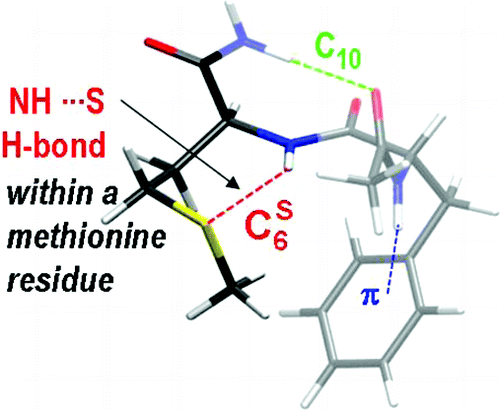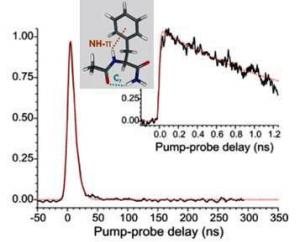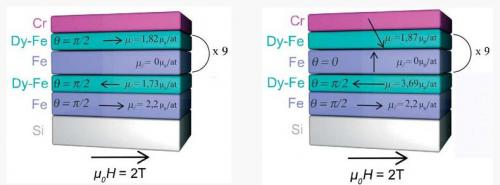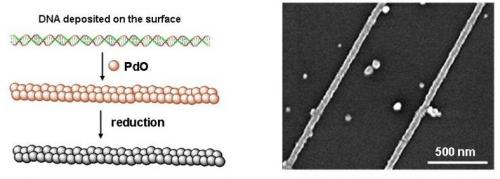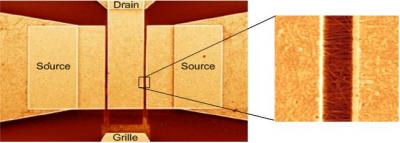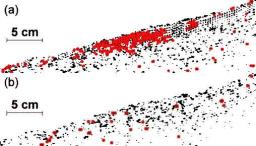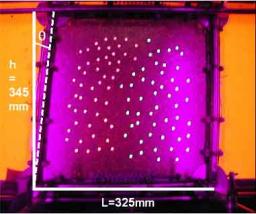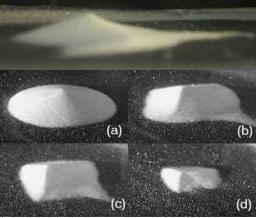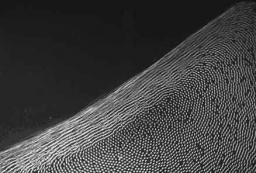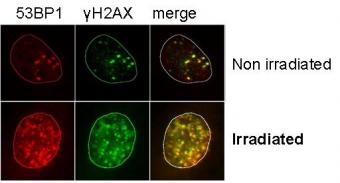2008
An important topic in the group aims at collecting accurate structural data in the gas phase to calibrate the modeling of molecular interactions controlling the structure of biomolecules.
Our assets are here the preparation and control of the molecules allowed by gas phase experiments (laser desorption coupled to a supersonic expansion, laser optical spectroscopic methods using several UV and IR lasers) as well as a real interplay between experiment and theory (Modelling of ground state structures and of IR spectra using quantum chemistry, modeling of relaxation processes in supersonic expansions, validation of new theoretical tools for the description of complex systems).
This important issue for biomolecules deals with the relationship between structure (conformation, environment), and dynamics (reactivity, relaxation). This topic is directly connected to the properties of proteins, following electronic excitation consecutive to a near UV photon absorption. Long-lived excited states are indeed potentially harmfull, since they provide opportunity for photochemistry to take place before the molecule relaxes its energy, leading to structural damages potentially affecting the function of the biomolecule. However, it has been suggested from both experimental hints and theoretical evidences that in biomolecules ultrafast relaxation phenomena can take place, allowing them to bypassing damaging photochemical phenomena. This aim of the present work is specifically to document the basic phenomena controlling the lifetime of the excited states, through
- An experimental characterization of the lifetimes, in pump-probe experiments at several timescales (nano-, pico-or femtosecond), and of the nature of the electronic states formed,
- A theoretical modeling of the processes involved, in particular the role of conical intersections among the several electronic states involved.
|
The generation of radical species triggered by nuclear reactions which produce elevated Linear Energy Transfer (LET) ionizing particles in aqueous media, as well as their reactivity, may be drastically affected by extreme thermodynamic conditions (temperatures higher than 300°C, pressures higher than 100 MPa, acidic or alkaline pH). Such effects are studied by experimental and computational techniques. |
A related project under development concerns the use of new energetic particle sources driven by high intensity lasers. These sources deliver femtosecond bunches of MeV-electrons and also high LET protons, carbons which rendering possible the study of their interaction with various molecular systems, probed by optical spectroscopy. |
In the pyrochlore compounds R2Mo2O7, both rare earth R3+ and M4+ transition metal ions form a threedimensional network of corner sharing tetrahedra. The pyrochlore lattice is geometrically frustrated both for antiferromagnetic (AF) and ferromagnetic (F) nearestneighbour exchange interactions, leading to intriguing magnetic states such as spin liquids, spin ices or chemically ordered spin glasses. Pyrochlores are extensively studied since their electrical and magnetic properties strongly depend on the rare earth ionic radius r. Compounds with small ionic radius Y, Dy and Tb are spin glass (SG) insulators, whereas those with Gd, Sm and Nd are ferromagnetic metals. (R,R')2Mo2O7 series with different substitutions on the R3+ site show a universal dependence of the transition temperature versus r [1], suggesting that Mo-Mo interactions change sign at a critical value rc, which controls the SGF threshold. Band structure calculations and photoemission experiments [2] point out that the concomitant changes of the transport and magnetic properties come from strong electron correlations in the Mo t2g band nearby the Fermi level. More...
The magnetization of [Fe 3nm/Dy 2nm] multilayers has been studied. The samples were thermally evaporated under ultra-high vacuum at different substrate temperatures varying from 320 K to 870 K. In order to get the magnetization depth profile of these Transition Metal/Rare Earth (TM/RE) multilayers, an investigation of the structural, chemical, and magnetic properties was carried out. The samples were studied by High Resolution Transmission Electron Microscopy (HRTEM), Three-Dimensional Atom Probe (3DAP) and Polarized Neutron Reflectivity (PNR). The multilayers have been found to be rather homogeneous, except for the first two bilayers deposited on the substrate : the mainly crystalline structure of the first Fe layers leads to an enhancement of the ordering temperature of amorphous Dy. Moreover, at low temperature, a negative exchange coupling between Fe and Dy layers has been evidenced. Magnetization profiles have also been calculated by Monte Carlo simulations to support the PNR fits.
Tuning nanotubes' absorption wave length
Carbon nanotubes possess exceptional electronic and mechanical properties, they appear to be very promising materials for electronic and sensing, polymer composites, energy conversion, or biological applications.
However, fabrication of nanotube-based molecular assemblies is still limited because of the difficulty to incorporate highly engineered molecules on the nanotube surfaces. The emerging field of “click chemistry” can bring very elegant solution to achieve easily nanotube-based functional materials. In 2001, Sharpless introduced this new concept in organic chemistry. The term “click chemistry” defines a chemical reaction which is versatile, clean with simple workup and purification procedures. Among the large collection of organic reactions, Huisgen cycloaddition represents actually the most effective reaction of the click chemistry. This reaction consists to 1,3-dipolar cycloaddition between azide and acetylene derivatives in the presence of Cu(I) catalyst.
Recently, we reported an example of SWNTs functionalized with Zn-phthalocyanine via “click chemistry”. We demonstrated that the SWNT-ZnPc conjugate could be used for the realization of optoelectronic devices (i.e. photovoltaic cells). We are currently working to extend this concept to the linkage of other functional molecules to nanotubes.
Thanks to the amazing selfassembly properties of DNA, structures of exquisite complexity can be built just in designing proper DNA sequences (DNA origami is the best example). They can be used in the further design of complex systems involving other nanoobjects, or for the preparation of functional devices. Our aim is to demonstrate the fabrication of carbon nanotube transistors by selfassembly on a DNA structure. DNA is used here not only to position the carbon nanotube in the transistor channel but also as support for current leads.
To ensure the conduction properties of DNA, we independently developed a novel approach for DNA metallization. In our approach the progressive growth of nanowires was achieved by the slow and selective precipitation of palladium oxide on DNA molecules previously deposited on a dry substrate in a typical nanodevice configuration. The second step consisted on the reduction of the palladium oxide into metallic palladium. We fabricated homogeneous, continuous and conductive DNA-based Pd nanowires with very thin diameter (20-25 nm).
Carbon nanotube based HF transistors
Thanks to their exceptional electronic properties, carbon nanotubes are a particularly well suited material for high frequency devices. Numerous predictions foresee that the cut off frequency of optimized carbon nanotube transistors would surpass classical semiconductor transistors. However, experimental realizations are scarce because the high impedance of single nanotubes (>10k Ohm) is not adapted to standard HF instruments (50 Ohms adapted). Besides, the carbon nanotube part of the complete device is usually very small, so that the noise issued from the rest of the device is usually overwhelming.
In collaboration with Gilles Dambrine’s team at IEMN (CNRS Lille), we built low impedance carbon nanotubes transistors constituted of a dense network of aligned nanotubes. Cut off frequencies above 10GHz have been obtained, which is the highest cut off frequency to date for carbon nanotube devices.
Introduction
Many industrial applications would benefit greatly of further insight into the mixing mechanisms of viscous fluids. The study of fluid mixing enhanced by closed flows goes back to the early 80’ s and the introduction of chaotic advection. The interest for mixing in open flows is more recent. Transient mixing created by an open flow whose time dependency is restricted to a bounded region – the mixing region – can be studied in the same dynamical systems framework as for bounded flows, since for typical open flows, Lagrangian trajectories have a transient chaotic behavior inside the mixing region. Nevertheless, quantitative analysis of homogenization realized by such flows is still lacking. We have characterized transient mixing in open flows and in parallel, we carried complementary investigations in closed flows as a guide on the less-beaten track of open flows.
Our study, experimental, numerical and theoretical, is based on two types of chaotic mixing experiments, in a closed vat and in an open channel. For closed flows, we have first proposed a topological description of mixing by the entanglement of periodic orbits that we called ”ghost rods”. The experimental study of the concentration field of a dye has then revealed the role of the walls of the domain where mixing takes place, in closed and open flows as well. For closed flows, the chaotic or regular nature of trajectories initialized close to the wall determines the evolution of the concentration field, even far from the walls. In particular, we have observed slow (algebraic) dynamics of homogenization when the chaotic region extends to no-slip walls. In open flows, we have reported on the evolution of the concentration field in the mixing and downstream regions, resulting from the injection of a dye blob. We have described the poorly mixed elements that escape quickly, as well as the asymptotic onset of a permanent (self-similar) pattern determined by the periodic orbits inside the mixing region. Finally, various models derived from the baker’s map have allowed us to understand most observed mechanisms.
A number of experimental works have studied surface instability of a granular heap, namely avalanches, and have led to the conclusion that such avalanches do not behave in a critical manner at all. In recent years, it has also been suggested that the jamming transition of granular materials could be analog to a glass transition. Further works on mean field glass models have developed this analogy and tried to unify concepts that had emerged in both fields, such as the dynamical temperature defined from fluctuation dissipation relations, and that related to Edwards' statistical ensemble.
First, the micro-displacements generated by a small localized overload at the free surface are visualized experimentally inside a packing of steel beads. For a triangular packing, beads rearrangements remain confined in two inverted triangles on both sides of the applied overload. This pattern disappears for stronger disorder. A simple model allows us to account for these observations and to relate them to the stress function response measured via photoelastic visualizations.
Granular media involve many particles, so that it is tempting to describe them thermodynamically. Unfortunately, energy is lost through friction and has to be brought by a non-thermal source. As a consequence, the dynamical equations do not leave any obvious ensemble invariant.
However it has been proposed that these systems could have a statistical mechanics of their own. Here, we present experimental results on the statistical properties of 2D disordered granular media under cyclic shear in an attempt to check the possibility of a thermodynamic construction for dense granular materials.
Dunes dynamics
Dunes dynamics has strong impact on the ecology and the economy of sandy areas, but is far from being understood. Since the work on sand dune formation by R.A. Bagnold, a world wide inventory of dunes has been developed. The most common dune, the so-called barchan, has a typical crescent shape normal to the wind, with arms downwind and forms under mono-directional winds. Various models call for more experimental data. On one hand, field measurements are difficult to perform and often incomplete. On the other hand, it is believed that dunes have a minimal size of the order of one meter, not reducible to smaller laboratory scales. We have set up a wind channel where to conduct experiments with sand and we have shown experimentally that an initial sand pile, under a wind flow charged in sand, flattens and exhibits a typical barchan shape before disappearing. An evolution law has been proposed for the profile and the summit of the dune. The dune dynamics is shape invariant. The invariant shape, the "dune function", was isolated. Our results, which clearly demonstrates the feasibility of dunes in the lab, open a new way of investigations in desert studies.
Surface flows
We investigate steady granular surface flows in a rotating drum, measuring the velocity profile in the flowing layer at the center of the drum, the flowing layer thickness and the static/flowing boundary profiles. The velocity varies linearly with depth, with a gradient independent of both the flowing layer thickness and the static/flowing boundary local slope. Then, writing the depth averaged conservation equations for granular surface flows, it was possible to find experimentally the constitutive relations needed to close these equations. Altogether it has brought the evidence that the relation between stress and strain is non local:
The GIT is very much involved in scientific popularization: conferences, exhibitions, articles, films...
Different "laptop experiments" have been constructed for this purpose. Most of the time, they are exposed in our "exhibition" room, where they can be demonstrated to the students and colleagues when visiting the lab. Also, we bring them outside of the lab, in the context of scientific popularization manifestations such as "Science en fête" or "L'Exposition de Physique".
Ion microbeams constitute today a powerful tool allowing the study of local response to irradiation in living cells. We have developed at the laboratory a facility which is now in operation and that allows to study in situ cell responses induced by the microbeam. As a reminder, it is possible to deliver a controlled number of particles in selected cells.
Experimental conditions are close in our case to standard culture conditions (culture and irradiation are performed with cells in horizontal plane, culture boxes of Petri dish type, controlled temperature and atmosphere environment), thus limiting experimental bias to unreached levels with this type of studies. We have recently evidenced in both targeted and non targeted cells (bystander cells) double strand breaks by using the immunodetection technique of γH2AX and 53BP1 proteins, 2 hours after irradiation. These two proteins are involved in the DNA break repair process.










